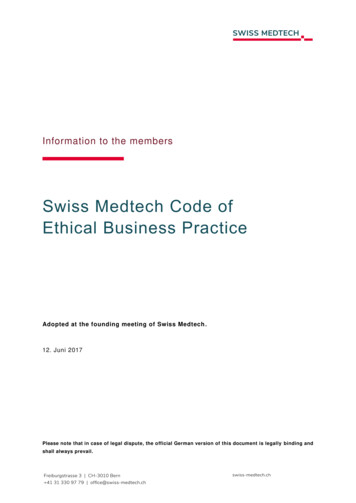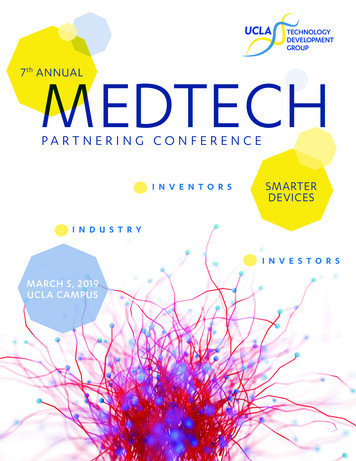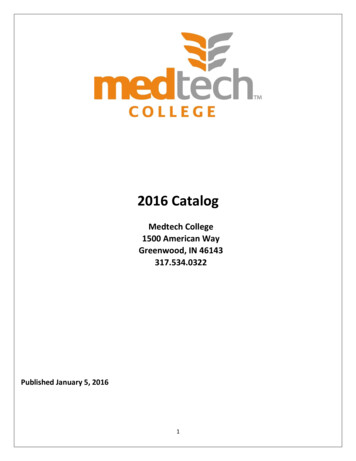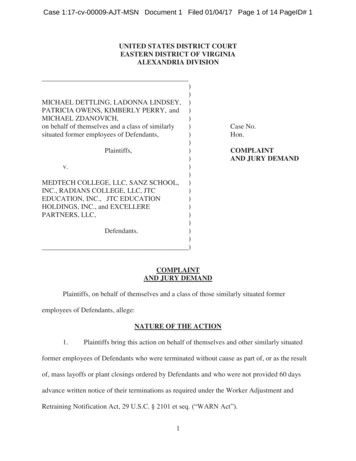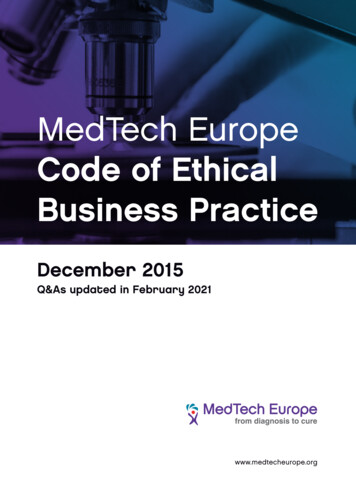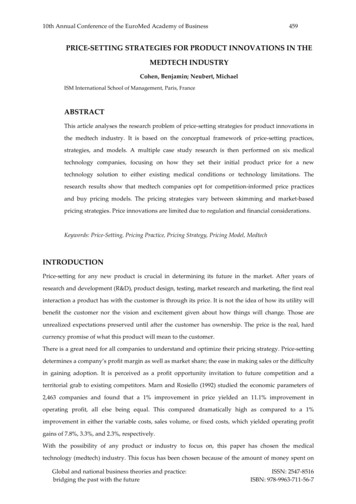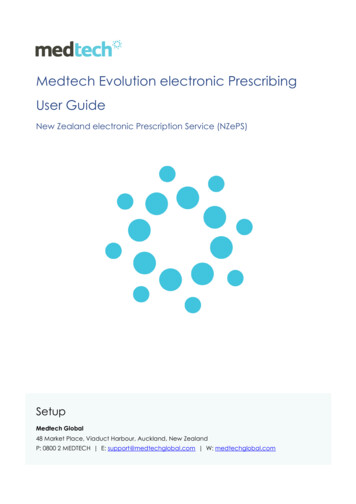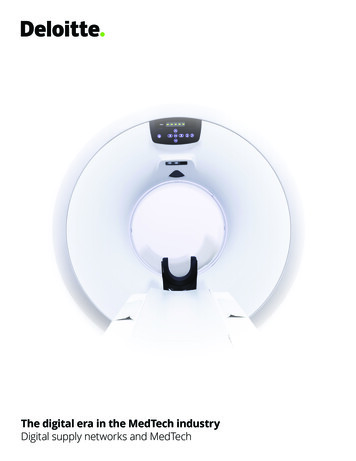
Transcription
SAMED & the SAmedtech industry
Content1.2.3.4.1About SAMED2i.ii.iii.iv.v.22356Who we areWhat we doOur strategic objectiveOur committeesOur membersSouth African medtech market7i.ii.79Size and composition of the marketMedical technology regulations, procurement and reimbursementSouth African health facilities11i.ii.1111Primary healthcare in focusHospital sectorDisclaimer12South African Medical Technology Industry Fact File
About SAMEDWho we areWhat we doThe South African Medical Technology IndustryAssociation (SAMED) is a not-for-gain industryassociation. As the voice of the South Africanmedtech and in-vitro diagnostics industry, SAMEDis committed to enabling a sustainable, ethicaland transformed medical technology industry thatadvances patient care through medtech.On behalf of our members, SAMED engages withpolicymakers, regulators, healthcareorganisations, professional societies, fundersand international agencies and alliances.In line with our Constitution we provide themedtech industry with a collective, objective andcredible platform for engagement with allstakeholders.SAMED was formed in 1985 by the followingfounding members: Brittan Healthcare Group;Browning Medical CC; Marcus Medical (Pty)Limited; Orthomedics (Pty) Limited; Safmed (Pty)Limited; Smith & Nephew (Pty) Limited; andSouthern Implants (Pty) Limited, all of which werelocal manufacturers at the time. The objective ofthe Association then was to engage with theRegulatory Authorities and call for the registrationof medical devices.Over the years SAMEDs membership has grownsignificantly and includes multinationals,distributors, wholesalers and local manufacturersof medical devices, medical equipment and invitro diagnostics (IVDs) (collectively referred to as‘medical technology’) as well as the South AfricanLaboratory and Diagnostic Association (SALDA)and the Medical Device Manufacturers Associationof South Africa (MDMSA).We develop and support patient-centric policiesthat enable people to live healthy andproductive lives.We provide solutions that enhance our country’shealthcare system and its productivity andaccountability.We host meetings and training workshops onmatters that impact the business andsustainability of member companies.We subscribe to the Government Gazette,Parliamentary Monitoring Group and tenderbulletins. From these we collect and providemembers with data that aids them in makinginformed business decisions.Our organisation advocates for harmonisation ofstandards and regulatory requirements for themanufacture, supply and use of medicaltechnology. To this end we are a member of twointernational organisations, the AsianHarmonisation Working Party and the GlobalMedical Technology Alliance, and work with ourindustry association counterparts includingMecomed in the Middle East, Medtech Europeand the USA-based AdvamedMedical technology plays a vital role across thecontinuum of patient care (prevention, screening,diagnosis, treatment and rehabilitation). As suchthe medical technology sector plays a significantrole in providing effective and efficient health carefor all South Africans.South African Medical Technology Industry Fact File2
About SAMEDOur strategic objectivesThe SAMED board sets and regularly reviewsour strategic objectives in consultation withSAMED committees and members. The currentSAMED strategy prioritises several areas, asexplained below.Policy, regulation and the legalframeworksTo benefit health outcomes and the nationalsocio-economic progress, South Africa needs awell-resourced and capacitated regulatorysystem for the manufacture, supply,procurement and application of medicaltechnology.SAMED advocates for the self-regulation of theindustry through the Medical Device Code onEthical Marketing and Business Practices. Theimplementation of the Code is supported by anindependently managed toll-freewhistleblowing hotline (0800 00 04 68).In order to strengthen the overall regulatory framework, we continually engage with the South African HealthProducts Regulatory Authority (SAHPRA), government including the Department of Health, Department of Trade,Industry and Competition, Department of Science and Innovation, Department of Small Business Developmentand National Treasury, the public and private health sector procurement and supply chain managers,healthcare providers and funders.Growing the local medical technology manufacturing sectorWe believe that South Africa’s home-grown manufacture of medical technology should be actively promotedand stepped up.A strong local medtech manufacturing sector is good for the economy. It would reduce the dependence onimporting most medical technologies, mainly from the “global North”. By manufacturing and buying locally, wecan grow and keep expertise and skills within South Africa. A more competitive local manufacturing capacitycan enhance our trade and collaborations within the African Union and strengthen local and African healthsystems to bring the continent closer to universal health coverage.3South African Medical Technology Industry Fact File
About SAMEDMacro-economic environmentSAMED builds on its focus on procurement and regulations as the foundation for driving legislation andpractices that ensure a sustainable medtech industry. We engage on the Healthcare Masterplan, aligning withthe dtic mandate and participate in the National Health Insurance and other policy discussions.Procurement and supply chain integritySAMED promotes clear, transparent, practicalprocurement processes that recognise thecomplexities of the medtech industry, ensurecontinuity of supply, and contribute to efficiency,accountability and sustainability of the healthcaresystem.SAMED supports a procurement model thatappreciates the value of innovative solutions andenhances competition by various players in theindustry to advance diversity across the medtechsupply chain. Innovation translates into value when itprevents disease and decreases patient waiting times,length of hospital stays, morbidity and mortality.A value-based healthcare and procurement approach: Helps healthcare providers and health systemsplan for the short/medium/long-termimplications of buying medical technology. Positions decisions on procurement within thecontext of wider patient and societal outcomestogether with the life-cycle cost of healthcaredelivery and services.SAMED also undertakes capacity building initiativesboth within our industry and with other stakeholdersoperating in procurement and supply chainmanagement in order to improve the planning, tenderspecifications and procurement management andmaintenance for medical technologies.South African Medical Technology Industry Fact File4
About SAMEDOur committeesThe SAMED board establishes and guides the work of committees that enable us to implement the SAMEDstrategy and to listen to, represent and support our members. Membership of committees from across ourdiverse association is voluntary and encouraged. Committees’ operations are supported by the SAMEDExecutive Officer and secretariat.Our Code Committee promotes the Medical Device Code and whistleblowing hotline as the cornerstones of themedtech industry’s self-regulation. It assists medical technology companies and healthcare providers in ethicalmarketing and business practices and interacts with third-party anti-corruption initiatives, including the HealthSector Anti-Corruption Forum which SAMED joined as a signatory in November 2019.Our Market Access Committee improves collaboration with public and private healthcare facilities and funders,strengthens supply chain management and tender processes, strengthens reimbursement and HTA mechanismsin the private and public sectors and participates in Council for Medical Schemes consultations.Our MISA (Medical Imaging South Africa) Committee represents the interests of companies operating in theimaging area of the medical technology industry.Our NHI Committee reviews, supports and contributes to the shaping of policy, legislation and the practicalimplementation of the National Health Insurance.Our Orthopaedics Committee represents the interests of members working in elective and trauma orthopaedicsand collaborates with the South African Orthopaedic Association.Our SAMED / SALDA Regulatory Committee contributes to a harmonised medical technology legislativeenvironment, engages on policy matters with the South African Health Products Regulatory Authority (SAHPRA)and other agencies tasked with the quality, safety and effectiveness of medical technology and hosts regulatoryforums to assist members with the implementation of regulations.Our Transformation Committee champions the transformation of the medical technology industry and individualcompanies as a socio-economic imperative and key factor of the industry’s sustainability.5South African Medical Technology Industry Fact File
About SAMEDOur membersSAMED membership comprises ordinary, association and associate members.Ordinary members include multinationals, distributors, wholesalers and local manufacturers of medicaldevices, medical equipment and IVDs.Association members are the South African Laboratory and Diagnostic Association (SALDA) and the MedicalDevice Manufacturers of South Africa (MDMSA).Associate members include consultants, training providers and logistic companies operating in the medicaltechnology industry.As a member of SAMED, you benefit in a variety of ways: Be part of a broad, diverse and dynamic association that has the expertise and commitment to advocate forand protect your rights and interests. Engage with a community of passionate, expert industry players on common challenges and successes. Join SAMED committees to directly address issues that affect our industry and your organisation. Develop skills and stay abreast of trends, best practices and industry developments by attending regularworkshops, conferences, forums and other frequent knowledge-sharing gatherings. Obtain guidance and support on local and international quality, licencing and regulatory requirements formedical technologies. Gain timely access to relevant remuneration news, benefit changes and policy trends in the market. Receive product and tender enquiries (local and international) and invitations to join in and outbound trademissions.The industry we represent employs more than 4 000 people and encompasses more than 500 000 differentmedical devices used in the diagnosis, prevention, treatment and amelioration of disease and disability. Theserange from sticking plasters and wheelchairs through to pacemakers and replacement joints.Please see the SAMED website (www.samed.org.za) for a list of our members.South African Medical Technology Industry Fact File6
The South Africanmedtech marketMedical technology is an essential element of health provision, along with care by healthcare practitioners(HCPs) and pharmaceuticals. The term medtech encompasses technologies from the relatively simple, such assyringes and personal protective equipment (PPE), to complex and high-technology devices, includingmagnetic resonance imaging (MRI) machines. The medical devices industry in South Africa is diverse – it spansfrom local manufacturers that specialise in a limited portfolio of products to multinational distributors thatcover numerous products and healthcare categories.Size and composition of the marketSouth Africa is one of the largest markets in the Middle East and Africa (MEA) region. Its large population (58.8min 2020, Stats SA) and Africa’s most industrialised economy support this emerging market. According to FitchSolutions, the medtech market is poised for considerable growth1.In 2019, the South African market was estimated to be worth 1.3 billion; 3.5% higher than in 2018. The marketis expected to increase further to US 1.8 billion by 2023. Apart from “other medical devices”, the single largestcategory in 2018 was consumables, making up about 19% of the total market2.South African medical technology market by product category, 2018CategoryConsumablesDiagnostic imagingOrthopaedics and prostheticsPatient aidsDental productsOther medical devicesTotalUSD Millions241.00199.30153.70156.0041.30487.101 278.40South Africa imports most of its medical technology/devices. The value of imports reached R15.2 billion in20183, compared to R2.67 billion in exports4.South Africa is the primary business hub for the medical technology industry in sub-Saharan Africa. A majorproportion of medical technology exports are to other countries in Africa, as shown in the table below.7South African Medical Technology Industry Fact File
The South Africanmedtech marketTop Sub-Saharan destinations for export of medtech from SA, sDemocratic Republic of CongoUSD 3.292.642.23South Africa’s spending on medical technology and devices as a proportion of wealth is on par with other MEAregion markets2.The use of medical devices in South Africa can be gauged by looking at the utilisation of certain devices bymedical scheme beneficiaries. By the end of 20185 medical schemes had 8 916 695 beneficiaries, or about 15%of the South African population. Table below sets out the utilisation of a number of procedures using medicaltechnologies. Most of these would have been performed in the private sector and are an underestimate of thetotal number of procedures performed in the country.Procedure (2018)AngiogramBone density scanCT (computerised tomography) scanMRI (magnetic resonance imaging) scanPET (positron emission tomography) scanNumber performed23 28930 334457 726274 2728 087South African Medical Technology Industry Fact FileNumber per day65831 254751228
The South Africanmedtech marketMedical technology regulations, procurement and reimbursementDue to the nature of the medical technology sector, various registration, licence and quality managementregulations apply to the industry.Legislative frameworks and agencies relevant to health regulation include the following:.National Health Act which provides aframework for a structured uniform healthsystem, taking into account the obligationsimposed by the Constitution and other lawson the national, provincial and localgovernments with regard to health services.Regulations for Medical Devices and IVDs,issued under the Medicines and RelatedSubstances Act 1965.The South African Health ProductsRegulatory Authority (SAHPRA), including thedepartment of radiation control, has themandate to ensure that the products under itscharge are safe, effective, of good quality andin the interest of the public throughout theirlifecycle. See www.sahpra.org for the currentlegislation, regulations and guidelinespertaining to medical devices and in-vitrodiagnostics.The Office of Health Standards Compliance(OHSC), created by the National HealthAmendment Act of 2013, has the mandate toprotect and promote the health and safety ofhealth services users. Its services includehealth inspections and the Health Ombud.The Council for Medical Schemes (CMS) is astatutory body established by the MedicalSchemes Act (131 of 1998) to provideregulatory supervision of private healthfinancing through medical schemes.9Firms operating in South Africa mustconsider Broad-Based Black EconomicEmpowerment (B-BBEE) whileconducting business. The Black EconomicEmpowerment (BEE) Act, No. 53 of 2003empowers the Minister of Trade, Industryand Competition (the dtic) to issue Codesof Good Practice and publishTransformation Charters; establish theBEE Advisory Council; and make provisionfor other related matters.Protection of Personal Information Act(POPIA) became effective on 1 July 2020.Its purpose is to protect people byprotecting their personal data. The Actimpacts on doctors, healthcareprofessionals, medical aids, insurancecompanies, pathologists, administrators,hospitals and organisations that need toprotect employee and patient personalhealth data.The National Health Insuranceprogramme is in the early stages ofimplementation. Legislatively, theNational Health Insurance Bill is underparliamentary review along with severalco-dependent acts and regulations.South African Medical Technology Industry Fact File
The South Africanmedtech marketThe government sector is the major purchaser of healthcareequipment and supplies. While a form of national tenderingexists, each province has its own tendering system.As part of initiatives to introduce national health insuranceand ensure universal health coverage, the government’sencouragement of public-private partnerships in thedevelopment of healthcare facilities is a new area of growth.Companies supplying primary healthcare products andservices may find opportunities within the clinicbuilding/refurbishment programmes, although for now,needs in this area are more directed towards basicinfrastructure rather than clinical supplies.Government tenders are geared towards supporting thebroader socio-economic objectives. Companies wishing tooperate in the public sector must demonstrate acommitment to the improvement of the health andeconomic status of the population in order to maintain asuccessful and continued presence in the market. This islinked to the Broad-based Black Economic Empowerment(B-BBEE) objectives, principles, targets and strategies. Arecent focus has been the regulation that all public tendersuppliers have to outsource 30% of the tender value tosmall and medium enterprises (SMEs) and qualifying smallenterprises (QSEs).6The Preferential Procurement Policy Framework Act (PPPFA) governs all government procurement withinSouth Africa. The PPPFA stipulates that when government assesses contracts, it must take into account apreference point system which prescribes functionality, price and reconstruction development programme(RDP) goals.The Public Procurement Bill, which when enacted into law will repeal the Preferential Procurement PolicyFramework Act (PPPFA), will impact on anyone that supplies goods and services to the public sector includingfuture NHI-related health sector procurement. The bill aims to eliminate fragmented procurement approachesand enhance the value of investment made into goods and services by government entities and programmes.The bill seeks to make public procurement more transparent and competitive and introduce measures toensure the integrity of the procurement process. It is anticipated that this will make tendering, procurementand payment across the public sector more predictable and accountableSouth African Medical Technology Industry Fact File10
South Africanhealth facilitiesSouth Africa currently has a two-tiered healthcare system, comprising the larger public (approximately 80% ofthe population) and the growing private sector. The country spent 9.0% of its GDP on healthcare in 2017 –higher than the 5% the World Health Organization (WHO) recommends for a country of its socio-economicstatus. However, despite this high expenditure, health outcomes remain poor in comparison with similarmiddle-income countries. This is primarily attributed to the inequities between the public and private sectors.7Primary healthcare in focusThe National Department of Health views a transition from a curative model of health service to one thatpromotes primary healthcare delivered as close to the community as possible as one of the key strategies tostrengthen the health system and improve health outcomes.Different initiatives, fostered by the NHI programme, are directed towards achieving this, and improving accessto and quality of primary and family healthcare. They include projects to strengthen existing and open newclinics and introduce and capacitate community health workers. In some areas, there is growing collaborationbetween the public and private health providers.Hospital sectorSouth Africa has a number of public (government-managed) hospitals within its nine provinces. These are splitinto three categories: academic (or tertiary), district and regional hospitals. For details, see links below.National Department of Health: http://www.health.gov.za/Gauteng Department of Health: e State Department of Health: /intranetEastern Cape Department of Health: http://www.ecprov.gov.za/Pages/default.aspxKwaZulu Natal Department of Health: http://www.kznhealth.gov.za/Limpopo Department of Health: http://www.doh.limpopo.gov.za/Mpumalanga Department of Health: http://www.mpuhealth.gov.za/North West Department of Health: http://health.nwpg.gov.za/dohnw/Northern Cape Department of Health: http://www.northern-cape.gov.za/Western Cape Department of Health: https://www.westerncape.gov.za/dept/healthIn addition, a number of private hospital groups operate in South Africa. Information on some of the largestgroups is available below.Life Healthcare Hospitals: www.lifehealthcare.co.zaMediclinic: www.mediclinic.co.zaNational Hospital Network (NHN): www.nhn.co.zaNetcare Ltd: www.netcare.co.za11South African Medical Technology Industry Fact File
DisclaimerDisclaimer: The information is provided by SAMED and whilst SAMED endeavours to ensure that the information is currentand correct, it makes no representations or warranties of any kind, express or implied, about the completeness, accuracy,reliability, suitability or availability of the information, including graphics, and offerings (collectively referred to as‘information’) contained in this document for any purpose. Any reliance placed by the user on such information istherefore strictly at the user's own risk. SAMED will not be liable for any loss or damages of whatsoever nature, includingwithout limitation, any direct, indirect, general, special, punitive, incidental or consequential damages, loss of use, loss ofdata, loss caused by a virus, loss of income or profit, loss of or damage to property and the like, claims of third parties orother losses of any kind or character, arising from or in connection with this document and/or accessing any informationthrough links included in this document.Figures prior to COVID-19 pandemicFitch Solutions; https://www.export.gov/article?id South-Africa-medical-devices; Africa Health: Market Insights: South Africa MedicalDevices Market 20193 SARS Trade Statistics Check4 ca-medical-devices25 Council for Medical Schemes (CMS) 2018 Annual Report6 t-policy-to-boost-growth-of-sme-says-zulu, -news/it-compulsory-sub-contract-part-tender7 h-africa/page-2.html12South African Medical Technology Industry Fact File12
medtech market Top Sub-Saharan destinations for export of medtech from SA, 20172 Country USD Millions Namibia 31.46 Botswana 18.85 Uganda 9.80 Swaziland 9.69 Zimbabwe 9.55 Zambia 5.90 Kenya 5.85 Mozambique 4.82 Lesotho 3.91 Malawi 3.47 Tanzania 3.29 Mauritius 2.64 Democratic Republic of Congo 2.23 Procedure (2018) Number performed Number per day


